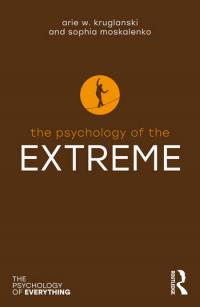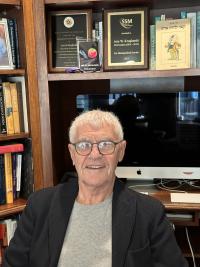Understanding Extremism–In the World, and In Ourselves
The word “extremist” might conjure up images of terrorist actions, hostile government takeovers, and crimes committed in the name of a religion. We may wonder what motivates these harmful extremists—who we consider to be “other." A UMD professor and his coauthor also want us to examine extremism in our communities, and in ourselves.

Distinguished University Professor Arie Kruglanski of the Department of Psychology and Dr. Sophia Moskalenko, a Research Fellow at Georgia State University, have long been interested in violent extremism, and spent years researching and publishing on related topics, including radicalization and conspiracy theories. Moskalenko also served as a Postdoctoral Research Fellow for START, UMD’s National Consortium for the Study of Terrorism and Responses to Terrorism, of which Kruglanski is a co-founder.
Kruglanski and Moskalenko explore the full spectrum of extremism, its biological roots, and its motivations in their new book, “The Psychology of the Extreme” (Routledge, 2025). The book helps us to understand that extremism can show up in our daily lives and in our habits, and can even be helpful.
“We realized that there is more to extremism than what meets the eye, and that gave us the idea for this volume,” Kruglanski said.
While many people may think of personal extremism as destructive—such as compulsive gambling, or engaging in divisive political rhetoric that harms relationships—American society often celebrates what we consider to be productive extremism. For example, we applaud the training and performance of elite athletes, an actor’s “method” commitment to a role, success in following a highly restrictive diet, or the rewards of being a “workaholic.”
“These personal forms of extremism are behaviors that we interact with every day. We all know someone who is dedicated to something, whether it is building model trains or training for a marathon,” Moskalenko said. “And so this basic psychology of extremism is much broader, much more relatable, and is much more familiar to people in their daily lives than the violent extremism that is in the news.”
Once readers recognize that extremism shows up in their daily lives and in their communities, the authors hope they will understand the nuances that have contributed to the world getting more extreme, in many ways. One driver of social extremism is social media.
“The proliferation of social media and the Internet allows us to socially compare ourselves, and so we become even more obsessed with whatever it is that holds our attention, whether it is fashion, or diets, or bodybuilding, or buying expensive things. All of a sudden, the stakes are greater because of this readily available comparison,” Moskalenko said. “And so, this is ‘daily extremism.’ Extremism is very much on the daily menu.”
Many people and societies celebrate extremism; many heroes are people who have done extreme and extraordinary things.

Kruglanski and Moskalenko named several luminaries as examples of extremism: Marie Curie, a physicist who dedicated her life to conduct research on radioactivity; Mahatma Gandhi, who employed extreme nonviolent resistance to fight for India’s independence from British rule; and basketball player Kobe Bryant, who was known to have given his all to practice, training, and pushing boundaries in his sport.
Once we understand that we can be and can admire “extremists,” we can better understand the extremism of other people, and groups of people.
“It’s important to develop a self-awareness of our capacity for extremism, and how to rechannel extremism into more socially constructive paths. It’s important to develop this understanding rather than to label extremism as ‘pathological,’ or ‘evil,’ or ‘morally reprehensible,’” Kruglanski said.
After all, extremism has biological roots, and can be a useful tool, the authors said. In this book, they show that extremism is an evolutionary mechanism that is important in times of emergencies.
“You need to be extreme in order to counter the emergency, such as a firefighter rescuing people from a burning building. But as with all evolutionary mechanisms, extremism can go astray, it can have unintended consequences. So we try to bring it all together to show the biological aspects of extremism, the necessity for it, and the cost that it exacts,” Kruglanski said.
Certainly the world has benefitted from the extremism of Curie and Gandhi. But we can draw misguided conclusions from our extreme heroes, the authors cautioned.

“Singular dedication to one’s field or craft comes at personal cost, including depression and burnout. Extremism’s hallmark is a kind of social isolation. We need to recognize the costs of extremism and weigh them against the benefits,” Moskalenko said.
There are also no guarantees to success because of extremism—for every Olympic medalist, there are thousands of athletes who have made similar sacrifices in extreme training in their sport, without the same level of achievement and recognition to show for it.
So what is the remedy for the downsides of extremism, both personally and on grander social scales? The authors say extremism is best exercised in moderation.
“A member of our team carried out research in 70 countries looking at the determinants of life satisfaction and well-being, and we have evidence that moderation rather than extremism promotes well-being. And this is true, across 70 different countries from different cultures, different mentalities in all other ways,” Kruglanski said. “So extremism does exact a cost, and in some cases, the cost actually comes to interfere with the efficacy of what the extremist is trying to achieve.”
Rather than an all-or-nothing approach to training, or work, or developing a talent, the authors recommend a balanced, moderate approach to achieving one’s goals.
A moderate approach can even help ease tension in the current political climate, Kruglanski said.
“There is a thirst in the American public and among members of publics around the world for an extremist leader or administration that is going to very decisively and clearly provide the solution to problems, because there's been a lot of uncertainty, a lot of anxiety in the last several decades, for a variety of reasons. There have been crises, one after the other: a globalization crisis, financial crises, the COVID-19 pandemic, the immigration crisis in the United States,” Kruglanski said. “Many people feel left behind. Many people feel uncertain and confused, and they are looking for someone who is going to cut through the morass of ambiguity and provide a solution, an extreme solution that would put an end to people’s misery.”
Thus, Kruglanski said, it is currently a ripe time for extremism around the world to rise. People would like to believe that extreme measures will solve problems, whereas moderate measures somehow fail to do so.
“Extremism requires several conditions to thrive. One is social comparison. So personal and political extremism is certainly heightened by social media. We feel more ‘on the stage’ than probably any generation before. That fuels extremism," Kruglanski said. "That is combined with the social isolation many of us feel, from being disconnected personally. But it’s all too easy to find like-minded others online, and so we have replaced real interactions with the connections we can make online. You may not find people who share your views in real life, but online, you can coordinate and share knowledge and share activities, and that fuels extremism.”
Along with moderation, the authors recommend in-person connections and building stronger communities to combat isolation and feelings of low self-worth, and to promote healthier relationships and feelings of belonging and significance.
“Sometimes, we forget to drink water, so we set a goal and we write it down. We need to remember that we need social interaction, and we need to connect with people, in person. We need to make that a goal, for our health,” Moskalenko said.
They also recommend setting realistic goals to pursue interests and work toward success in a healthy, balanced way.
“A writer could take the example of Ernest Hemingway, who found he was getting depressed when he woke up early to write all day. Instead, he set a goal of one thousand words a day, about four pages, double-spaced. He found he was happier and a better writer for it,” Moskalenko said. “We gain confidence from setting and meeting smaller goals, so we have the motivation to keep going.”
Kruglanski said he hopes that everyone will benefit from the book, but especially policymakers, educators, and “young people who are facing the turbulent environment that seems to exist today.”
“We can all benefit from understanding: self-understanding, and understanding extremism in the world, and how to counteract it and calm things down,” Kruglanski said.
Illustration via iStock
Published on Mon, Feb 10, 2025 - 3:14PM




